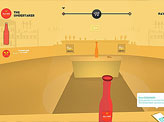For decades, newspaper front pages were one of the most valuable pieces of real estate in the communications world. Every square inch of the top broadsheet was formatted to guide readers’ eyes from one content-rich article to another. Though newspapers have lost some cultural capital recently, website homepages have taken over their role as the critical focus of contemporary eyes.
Homepage design is serious business that you should be sweating over. When a user navigates to your website, you have literal seconds to preserve their attention before they jump ship and find another source for their desired information. As such, everything on your website’s homepage – from its visual identity to its load time – must be optimized for those few analytical seconds.
Finding the right homepage recipe can depend greatly on your website’s focus. For instance, widgets are one way to add a great visual element to your homepage. But no matter what you use your website for, these four homepage design ideas will help you brainstorm new ways to optimize your digital front page.
Idea #1: Optimize Page Load Time
Before discussing the creative aspects of a website homepage design, there are several key technical aspects that you need to get a handle of in order to ensure maximum website retention.
As noted, most website visitors will abandon ship in mere seconds if they don’t see something worth engaging with. By and large, one of the biggest reasons these visitors leave immediately is because their desired web page is taking too long to load (relatively speaking).
In light of the advent of high-speed internet, users have grown to hold split-second reaction times regarding individual page load times. A slow loading homepage is an awful first impression upon these users, so you should ensure that every component under the homepage’s hood is humming smoothly at all times.
One of the quickest ways to speed up your homepage is by choosing a quality web host. Hosting reviews are the best places to go to learn about which hosts provide the fastest load times. Moreover, these reviews also tend to include details about each platform’s design tools, allowing you to optimize both technical and creative elements of your website homepage at once.
Also, you should strongly consider implementing page loading optimization protocols such as caching and redirect minimization. All of these minor details will really work together to shave whole seconds off your homepage load time if implemented with precision.
Idea #2: Display Your Identity Front and Center
For a long time, many commuters and office workers picked up their daily newspaper from a corner newsstand. In order to pick up their favored paper, eager readers would look for their brand’s unique masthead. This area carried the paper’s name and logo, making for a memorable experience that was easily attributable to the core brand.
Though websites don’t need to worry about fighting for visibility on a physical newsstand, they do need to make their unique identity known and unmistakably memorable. As such, your website homepage design should always place your key identity assets “front and center” in terms of importance.
This idea shouldn’t necessarily be taken as a literal formatting suggestion. Instead, you should decide upon a location on your homepage where your logo and other branding marks will immediately appear. Ideally, this location will carry through all other pages on the website in order to create a functional unity.
The brand recall will be essential when it comes to generating repeat traffic for your website, so be sure to take the time necessary to display your key identity elements in a position of prominence.
Idea #3: Establish a Visual Identity
As with your key identity assets, your full visual identity can play a critical role in making your website memorable and, in many regards, legible. Internet users who lived through the “dot com” bubble around the year 2000 will likely recall the gaudiness that hand-made web domains clung to well up to the demise of GeoCities. Today, you can do a lot better than those visual hack jobs of old.
First and foremost, your homepage design should focus around two to three harmonious colors that will welcome visitors in through a mix of curiosity and contrast. Also, be sure to pick at least one neutral background color upon which either black or white text can be easily read.
If you are using a website building platform, you’ll have even more support when it comes to establishing your website homepage visuals. Often, these platforms use simplified drag-and-drop menus that make it easy to pick colors that visually jive while still leaving room for creativity.
Idea #4: Include Connections to Recent Content
Newspaper editors often speak of what news is above and below the literal fold in most every consumer newspaper. Stories placed “above the fold” were considered to be the most hard-hitting, most engaging journalistic endeavors that would bring in more reader. Though digital in nature, website designers must also consider what content they will place “above the fold” on their new homepage.
Precise choices regarding content inclusions should be left to your editorial discretion. However, when choosing what content to place on your homepage design, remember to include at least a sampling of your most recent content. Return users will appreciate seeing such content-based updates since their previous visit.
Also, try to include some type of visual component that attracts visitors’ eyes as soon as it loads in. No matter what recent content you include on your homepage, remember that it should be a fundamental representation of your high-quality control standards. Use this crucial piece of real estate wisely and you’ll be rewarded with a loyal following in no time.
Rethink Your Website Homepage Design
Website homepage design can be tricky, especially for first-timers or those with minimal creative input. Even so, you’ll find yourself on the path towards publishing a vivid, engaging homepage in no time if you stick to these four homepage design ideas.
Once you have these core components, don’t forget to undertake a bit of live testing. By testing your homepage on desktop, tablet, and mobile phone browsers, you’ll be able to identify even more room for improvement. Then, you can turn this creative and technical process into a cyclical program that builds your homepage slowly but surely into its best possible form.















